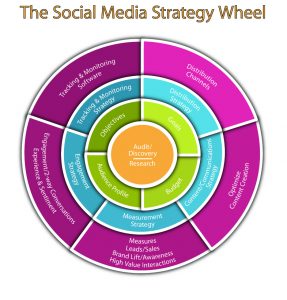Social media has changed the world of PR and it’s for the better. You may hear about the challenges of technology (yes, they exist) but there are also tremendous benefits. Social media is about people, however, the technology helps to facilitate the great interactions we experience. When companies use social media strategically in the communication planning process, with greater audience intelligence and market insights they are better prepared to handle a dynamic and socially engaged public to achieve their intended communication goals.
Social media helps you to gather intelligence and to become more intimate with your customers and other important stakeholders. If you’re using social media in your planning, then you will be ready for not only the highly informative discussions and engagement with your audience, but also to uncover and minimize the negative issues that arise during your campaign. For a minimal investment of time and resources, you learn more about your audiences, create more compelling stories, uncover potential damaging issues, deliver better experiences that result in stronger relationships and trust, and have the flexibility to adjust your messaging in real-time for greater results.
The Social Media Strategy Wheel
A few years ago, I created the Social Media Strategy Wheel Infographic for PR professionals. The wheel was designed to help you during the planning process. The Infographic is a visual graphic broken down into different areas of focus, which are critical during the planning process.
Good Planning Includes Social Media
The time you spend on your strategic planning is a direct reflection of your program results. In the spirit of good planning, here are five important areas, based on the Social Media Strategy Wheel, to demonstrate how social media can be used for deeper intelligence and more relevant communication. So, hold off on the tweets, Facebook updates, Instagram posts and snaps on Snapchat (the communication tactics) until you address social media by using it as a part of your planning process:
- Get closer to your customers and learn about the market through social media data and analytics. We are in an age of PR Tech and data literacy. Rolling up your sleeves to “listen” more actively and to monitor conversations closely will help you to identify your audience’s pain points, areas of passion, ideas that spark action, and trending topics in different communities. Of course, using social media data along with web analytics, customer service, and sales and marketing data helps to paint a much clearer picture of your customers and how they feel about your business. When you can integrate your data findings with data from other areas of the organization, you are breaking down the silos and creating opportunities for a better customer experience.
- Use social media to learn what your competitors are doing, saying, sharing and how their stakeholders are feeling about them vs. your company, products or services. It’s not just the corporate communications department who does the talking; every department with employees across the company have a voice. You can quickly evaluate what competitive companies are doing based on brand messaging, level of engagement and the level of interest in their content against what you share to visualize who is really capturing market mindshare and consumer heart-share.
- Identify important media contacts and new influencers including: bloggers, YouTubers, Instagrammers, Twitter personalities, etc., who are driving critical conversations, news stories and content related to important issues. These are the influential community members with the larger to the smaller followings (remember popularity doesn’t matter, if it doesn’t move the needle) who know how to get their community member to act. The ability to drive action is what is so attractive to companies who want to amplify their messages and have influencers advocate on their behalf.
- Create transparent and human stories, through the appropriate channels to engage your stakeholders; the way they want to experience and interact with you. Based on the cultural norms of different social communities, you can determine what type of stories that resonate as well as the most favorable content formats for deeper engagement with community members. Knowing what consumers expect and prefer from you through different channels helps you to create the content that will get and keep an audience’s attention.
- Know what you want to achieve from the onset. Setting clear goals and objectives at the start of your planning process is the only way to set up your measurement program, benchmarking your progress and program success. However, it’s not just your communication goals (exposure, message retention, engagement, etc.) but it is also how you tie your communication efforts back in to higher-level business goals and objectives. When you want the attention of the C-suite, you have to connect your efforts to the financial buckets, which include brand health, revenue generation, employee productivity, marketing optimization and customer satisfaction. Social media is the channel that can help you to measure both your communication and higher level business goals.
When you use social media strategically in your planning process, you are able to increase your intelligence, neutralize the negative, deepen engagement, plan and create better experiences for your audiences and deliver value to your organization. Communication impact can take the form of stronger relationships, increased brand awareness, heightened exposure, a more favorable reputation and the ability to avert issues and crisis.
Deirdre Breakenridge is CEO of Pure Performance Communications. She is an international speaker, podcaster, Lynda.com video author and an adjunct professor and online instructor at UMASS at Amherst and Rutgers University. Her most recent book published by FT Press is Social Media and Public Relations: Eight New Practices for the PR Professional.









Can the use of social media work for all companies? Considering that clients differ from one company to another.
Absolutely. Strategies should be tailored accordingly; however, even organizations dealing with the most sensitive of topic can benefit from leveraging social media. @MarineCory
[…] Social media makes your PR planning process more strategic (via PRSA) […]
Great post, and really helpful tips